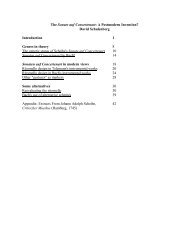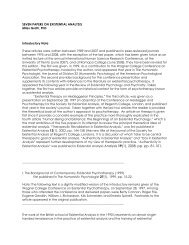download
download
download
You also want an ePaper? Increase the reach of your titles
YUMPU automatically turns print PDFs into web optimized ePapers that Google loves.
Schulenberg: Froberger, AMS 2006, p. 8<br />
14<br />
interpretation; the two senses seem to merge in Froberger's pieces. The player of the toccatas<br />
and allemandes in the Berlin mauscript would have had to recognize immediately the changing<br />
affects or passions signalled by the musical surface, responding with swift yet musically coherent<br />
variations in the tempo or in the style of any added ornamentation or rhythmic alteration. The<br />
need for “discretion” in performance might have been obvious to those who had heard Froberger<br />
in person. That later players required encouragement in this regard is implied by the proliferating<br />
indications for “discretion” in later sources, especially the Berlin manuscript.<br />
“Discretion” for a seventeenth-century keyboard player might have included the<br />
connection that a player makes between changing mental images or passions and the changing<br />
sounds produced through the instrument. In Cartesian language, the sounds of a performance<br />
would have been aural representations of whatever the player was feeling or imagining. Unlike<br />
the ineffable affects of later musical aesthetics, these images and passions were real presences in<br />
the mind of the player or listener, mediated by the equally real, physical contact of the fingers on<br />
the keys. Images and feelings described in titles and annotations were genuinely present if the<br />
player was conscious of them and responded to them musically. But a player who was unaware<br />
of the proper images or passions could not play the pieces as the composer had done. At the end<br />
of his life, Froberger was reportedly unwilling to let his best music circulate, because players<br />
15<br />
who lacked the proper “discretion” would only spoil it. Perhaps one reason for this<br />
unwillingness was that Froberger had failed to indicate precisely, in his own manuscripts, where<br />
discretion was to be employed, or what events and feelings his various pieces were meant to<br />
memorialize. If so, the Berlin manuscript may be the product of an effort by a pupil or admirer of<br />
Froberger to clarify and preserve his tradition.<br />
Yet by the end of the seventeenth century, the type of musical representation seen in most<br />
of Froberger's programmatic pieces was being replaced by another. Even in allemande 27, it is<br />
the pathos rather than the action that is most vividly represented, by the four “correspondences of<br />
affect” listed in table 4. Kuhnau, and even the young Bach, if they were in fact responding to<br />
something in Froberger's music, failed to catch it, since what they do in their programmatic<br />
pieces is more concrete, more programmatic in the strict sense of the term. French composers<br />
such as François Couperin, although occasionally writing pieces that are also narrative in a literal<br />
sense, are more elusive. They do not, I think, aim at representing the composer's or player's actual<br />
mental states in the way that I believe Froberger to have done. Rather they aim, when they write<br />
representationally, at representing objects, or else people considered as objects of contemplation<br />
or even as puzzles. So Couperin's portrait of the Princesse de La Conti is, to quote his subtitle,<br />
full of incomparable grace. His presumed self-portrait in La Couperin is by turns witty and<br />
phlegmatic, in a way that raises the question of whether the music really represents facets of the<br />
composer's true inner self. In neither work are we told that the music describes an event or even<br />
14<br />
Howard Schott, “Parameters of Interpretation in the Music of Froberger,” in J. J.<br />
Froberger: Musicien européen ([Paris:] Klincksieck, 1998), 102–4.<br />
15 Or at least so Duchess Sibylla indicated to Constantijn Huygens in her famous letter of<br />
Oct. 23, 1667 (Nov. 2, 1667, new style), translated by Rasch, “The Huygens-Froberger-Sibylla<br />
Correspondence,” 242.















